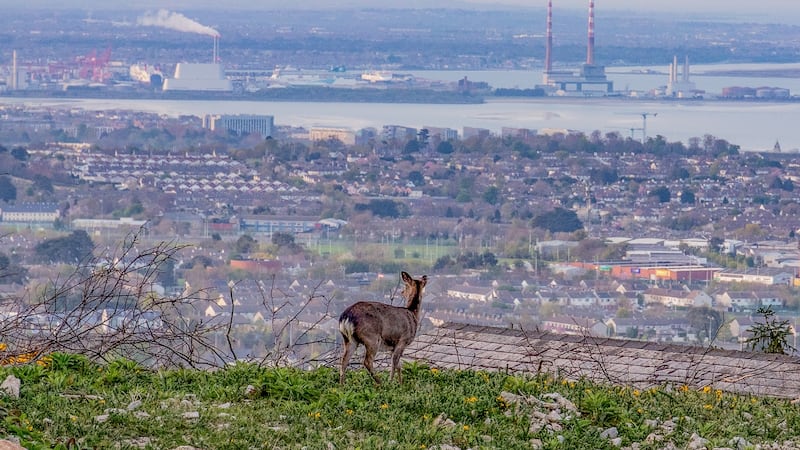Hits on the Birdwatch Ireland website are up 350 per cent as a society in shutdown takes more notice of the natural world.
The spike in interest comes at a time when not just birds but plants, marine life, insects and even our skies are all affected by the sudden reduction of human activity prompted by the fight against coronavirus.
"I've noticed the ravens are more relaxed," says Matthew Jebb, director of the National Botanic Gardens in Dublin, which are closed as part of the Government's containment measures.
“At weekends on a good day, [there] could be up to four or five thousand people, and the birds are never, ever, comfortable or settled. But now it’s so quiet, they won’t see a person all day, and it just gives them that added confidence in going about their nesting.”
There is a lot of research going on, he says, about the effect of traffic noise on birds’ efforts to lure a mate. Birds sing early in the morning to mark their territory and to attract partners, but unfortunately this usually coincides with both the early morning rush hour and early morning flights.
“Now the noise levels in Dublin have dropped by almost one-third and it has become very calm and quiet.”

Air quality
The cleaner air we are experiencing will be good for plants, as newly emerging leaves will be subject to far less day-to-day pollution, says Jebb. “The delicate new leaves get a cleaner sweep, and a much better start in life.”
"A lot of people are asking us has the lockdown produced more birds, and the answer is no," says Niall Hatch of Birdwatch Ireland. "The number of birds is the same as it has always been. It is just people are more aware of them than they have normally been."
People are spending more time in their own gardens, if they have one, and the unusual quiet in cities means that birdsong is more noticeable. It is also the case that because of the quiet, sound travels more.
The shutdown has also had an impact on some, though not all, catches of marine life covered by the EU quota system.
Fishing for prawns, crabs and lobsters, as well as demersal, such as whiting, haddock and monkfish, is below what it would normally be for this time of year (with 10 per cent, rather than 25 per cent, of quotas used). However the fishing of blue whiting, mackerel and horse mackerel continues at normal levels.
The closure of markets for some product has hit the Irish fishing industry hard, but scientists will be closely monitoring the effect on marine population levels off our shores.
Climate science
The drop in economic activity has also provided a type of enormous laboratory experiment for scientists involved in studying the related issues of cloud formation, dirty air and climate change.
Data from Eurocontrol show flights across Europe, as of earlier this week, were down by approximately 90 per cent, with the figure for Ireland, including overflights, being 92 per cent down.
In the immediate wake of the 9/11 attacks in the United States, all non-military flights over US airspace were grounded for a number of days. Scientists in Wisconsin were able to study the behaviour of contrail cirrus cloud – the cloud created by the vapour from jet engines – left by military flights travelling across otherwise empty skies.
"They were able to track contrails associated with very specific military flights," says Rowan Fealy, who lectures on climate science in the geography department of Maynooth University. "They found that the contrails associated with just six military aircraft were able to fan out to cover a region of about seven and a half thousand square miles. These can impact for a number of hours after they have formed."
Climate scientists find this interesting because of the “energy balance” impact high-level clouds can have on global warming. Contrail cirrus cloud can keep energy out during the day, and keep energy in at night when the earth is cooling down.
“Now we have potentially a much, much bigger data sample beyond that of 9/11,” Fealy says. “In spite of the tragic circumstances of the global pandemic, we do have some really interesting opportunities in the sense that we have real-world conditions that we can now look at and analyse.”
‘Global dimming’
Another big issue for climate scientists is “global dimming”, or the impact of air pollution on the ability of the sun’s light or energy to reach the earth’s surface. Recent figures from Nasa, the US space agency, have shown huge drop-offs in air pollution over major cities.
Global dimming may have the effect of constraining the temperature increases caused by greenhouse gases.
Hannah Hamilton, communications manager with Coillte Nature, says it is a bit early to speak about the effect of the shutdown on wildlife, though undoubtedly there will be less roadkill, and it is well known that noise pollution affects animals negatively.
“The key thing is not the effect on wildlife so much as the extent to which we are noticing more. We are living slower lives, limited in the places we are going, and we are noticing what is around us in a way that we don’t normally do.”
This, she says, is exactly what scientists and naturalists do all of the time. A positive aspect of the shutdown is that more people are now having the opportunity to “take pause and just look around.”
She is hoping that, once the awfulness of the pandemic has passed, people will have an increased “natural literacy” and that this increased engagement with the natural world will endure.








